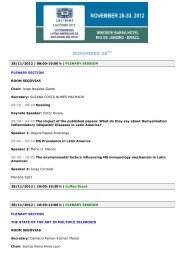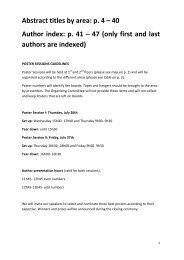Keynote Conference - Interevent
Keynote Conference - Interevent
Keynote Conference - Interevent
You also want an ePaper? Increase the reach of your titles
YUMPU automatically turns print PDFs into web optimized ePapers that Google loves.
Symp#7 Signaling in development<br />
Chair Ricardo Guelerman Pinheiro Ramos<br />
Ricardo Guelerman Pinheiro Ramos<br />
University of São Paulo, Ribeirão Preto, Brazil<br />
Introductory notes<br />
Wnt Signaling, Stem Cells and Tissue Repair<br />
Roel Nusse, Howard Hughes Medical Institute, Department of Developmental Biology, Lorry I. Lokey Stem Cell<br />
Research Building. Stanford<br />
Work from many laboratories has shown that Wnt signals are essential for the control over stem cells. A right balance<br />
between the number of stem and differentiated cells is essential for the proper function of organs. Locally acting<br />
signals, including Wnts, are important to maintain this balance in a spatially organized manner and these signals are<br />
key to understanding the regulation of growth. How this is achieved is far from clear and is the subject of studies in our<br />
lab, both in vivo and in cell culture. In vivo, a particular question we address is how physiological changes, such as<br />
those occurring during hormonal stimuli, injury or programmed tissue degeneration have an impact on the selfrenewal<br />
signals and on stem cell biology. Current research includes: 1) Identifying and tracing Wnt-responsive stem<br />
cells in tissues; 2) mapping cis-acting transcriptional control elements (enhancers) that control Wnt gene expression in<br />
normal and injured tissues; 3) the use of active Wnt proteins to maintain stem cells (including embryonic stem cells) in<br />
cell culture; 4) presenting Wnt protein in a vectorial manner to stem cells to direct asymmetric cell division.<br />
Formation of the Vertebrate Body Axis<br />
Olivier Pourquié<br />
Institut de genétique et biologie moleculaire et celulaire, INSERM, France<br />
Hedgehog Signaling in Development and Disease<br />
Matthew Scott<br />
Departments of Developmental Biology, Genetics, and Bioengineering, Howard Hughes Medical Institute, Clark Center<br />
West Wing W252, 318 Campus Drive, Stanford University School of Medicine, Stanford, California 94305-5439<br />
Phone 650-725-7680 Fax (650) 725-2952<br />
Hedgehog (Hh) signaling is important for the development of most organs and tissues. Damage to Hh signal<br />
transduction components causes birth defects and cancer. We have been exploring four areas of Hedgehog signaling:<br />
transduction in primary cilia, roles of Neuropilin proteins, identification of direct Hh target genes in the cerebellum and<br />
medulloblastomas (MBs), and mutations in MB tumor genomes. Neuropilins 1 and 2 (Nrp1, 2) are transmembrane<br />
proteins with roles in axon guidance and vascular endothelial growth factor (VEGF) signaling. We found that they are<br />
important positive regulators of Hh signal transduction. Nrps are expressed at times and locations of active Hh signal<br />
transduction during mouse development. We show that Nrps mediate Hh transduction between activated<br />
Smoothened (Smo) protein and the negative regulator Suppressor of Fused (SuFu). Nrp1 transcription is induced by<br />
Hh signaling and Nrp1 over-expression increases maximal Hh target gene activation, indicating the existence of a<br />
positive feedback circuit. We are testing the importance of Nrps for growth of MB cells. Nrps act upstream of Gli<br />
proteins, transcription factors that directly control Hh target gene transcription. We have identified direct targets of<br />
Gli1 in normal mouse cerebellum development and in MBs, and found that Gli1 is located at some common genes in<br />
the two cell types as well as many locations unique to each cell type. To understand better the properties of MB<br />
tumor cells we are determining exome sequences of human and mouse tumors.<br />
59





